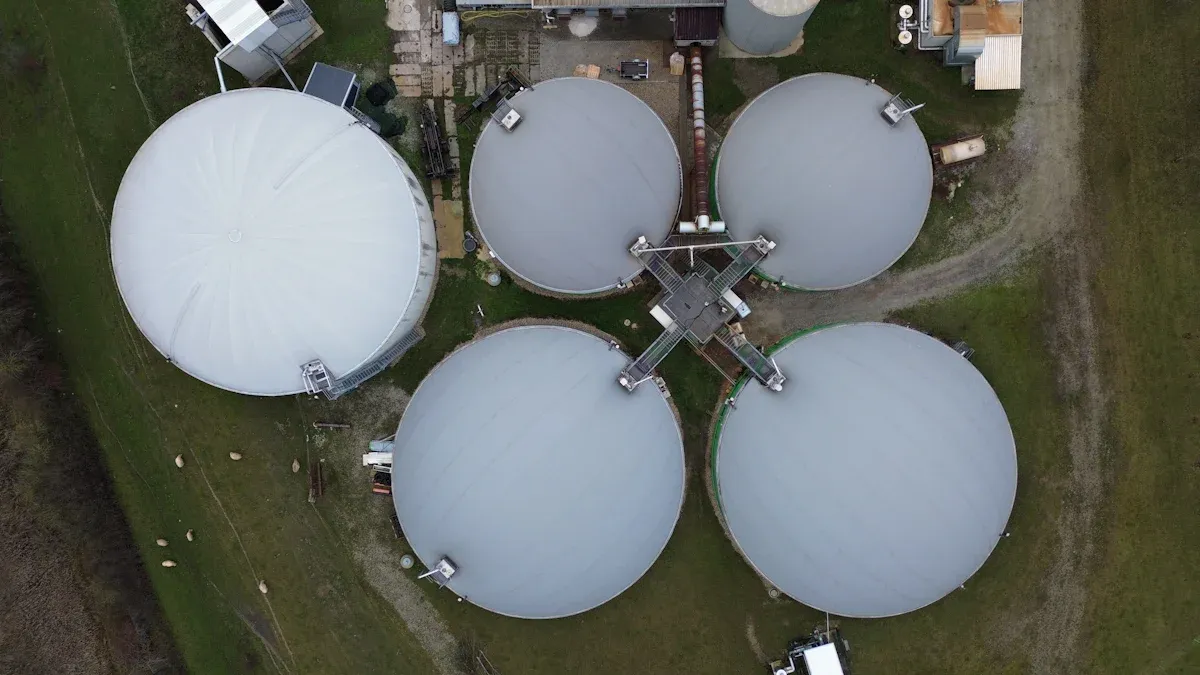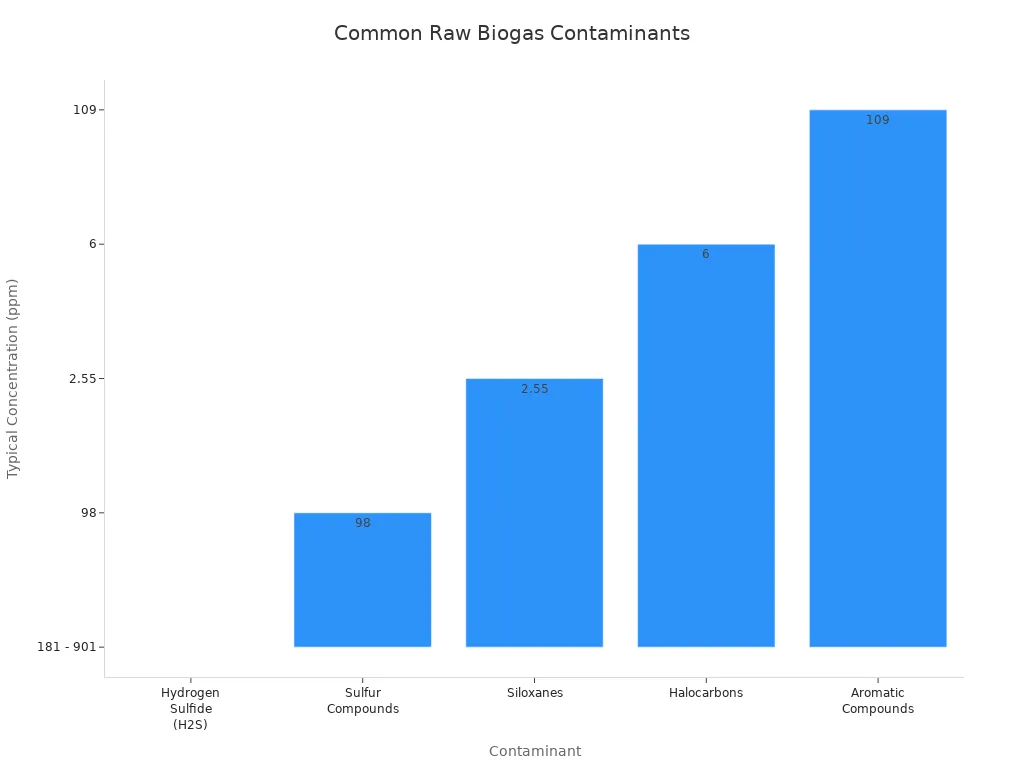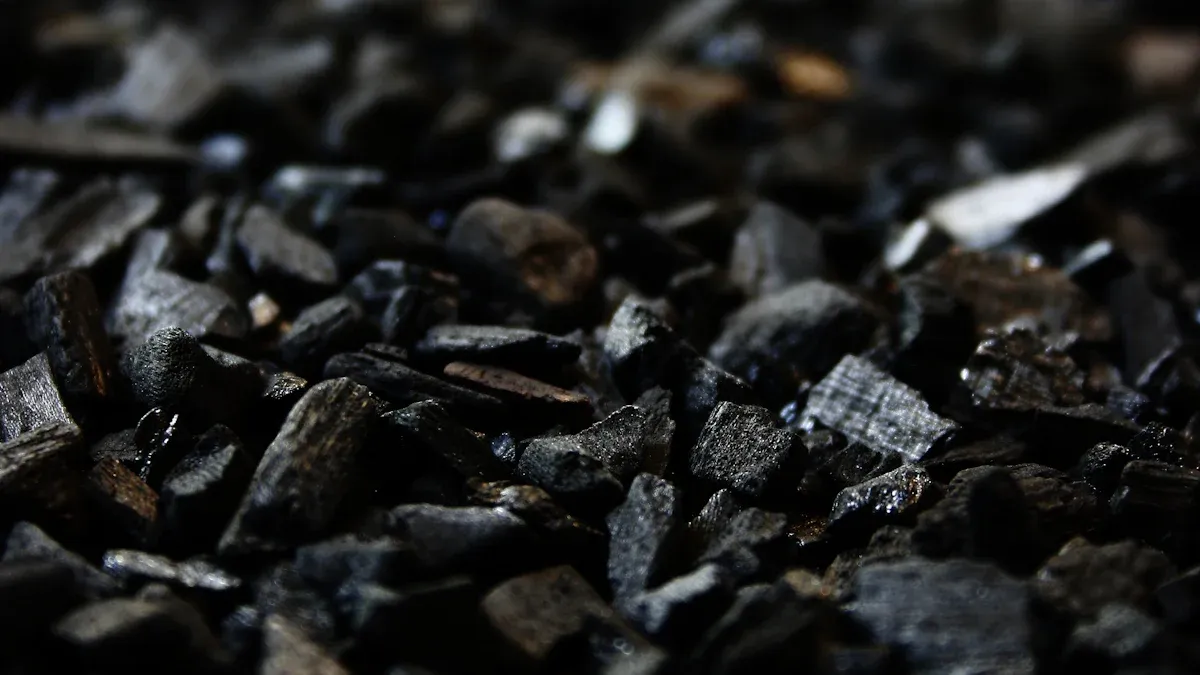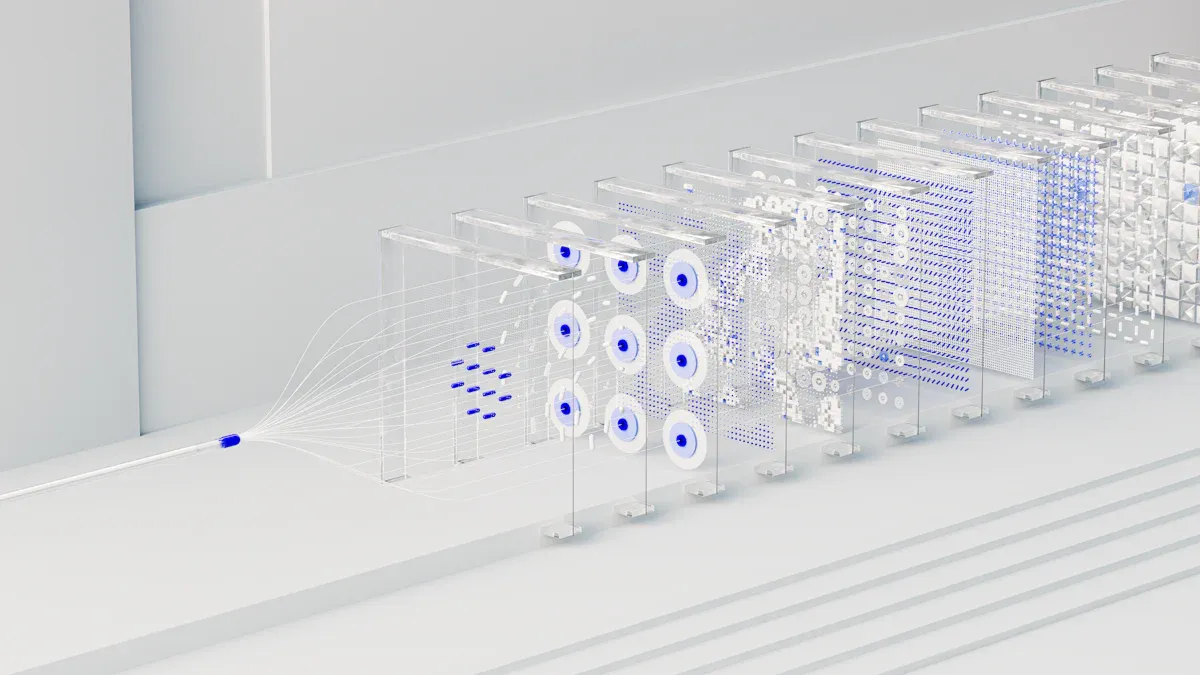
Utiliza Carbón activado para biogás to catch bad substances in biogas before it gets to your machines. This step is called biogas purification. It keeps engines safe and makes the fuel better. Raw biogas has things like hydrogen sulfide, ammonia, siloxanes, and volatile organic compounds. These things can rust or hurt your equipment.

Taking out these bad things makes your system safer and helps it work better.
Principales conclusiones
Cleaning biogas is important to take out harmful things like hydrogen sulfide and ammonia. This keeps your machines safe and helps them use energy better.
Picking the right activated carbon is very important. Some types work better for certain bad things, so choose the carbon that fits your biogas.
Check and change activated carbon filters often. If you smell bad odors or the filters feel heavy, it means you need to change them. This keeps your system working well.
Using two filters lets your system keep running. One filter can work while you change the other one. This means your system does not have to stop.
Doing good maintenance, like looking for leaks and checking gas flow, keeps your biogas system safe and working well.
Biogas Purification Basics
Why Purify Biogas
Debes clean biogas before using it in engines or boilers. Purifying biogas helps you get more energy from it. It also keeps your machines safe from harm. Taking out harmful substances makes the gas good for different machines. If you do not clean the gas, your equipment can get damaged. Hydrogen sulfide can make metal parts rust. Dirty gas can make engines work badly. You may also have trouble with how well your machines run.
Tip: Cleaning biogas helps you follow safety laws. Many places have rules for methane, impurities, and water in biogas. You need to take out water and bad substances like hydrogen sulfide and volatile organic compounds to follow these rules.
Here are the main reasons to clean biogas:
Keep engines, boilers, and vehicles safe
Make sure the gas works for many uses
If you skip cleaning biogas, you might get:
Bad gas quality and weak performance
Trouble running engines smoothly
Common Contaminants
Biogas is mostly methane and carbon dioxide. It also has small amounts of hydrogen sulfide, ammonia, siloxanes, and volatile organic compounds. Hydrogen sulfide is very dangerous. It is poisonous and can hurt your machines. The California Air Resources Board says these bad things can make toxic stuff when you burn biogas. This can hurt your machines and pollute the air.
Contaminante | Risk to Equipment | Why Remove? |
|---|---|---|
Hydrogen Sulfide | Corrosion, toxicity | Protect engines, safety |
Ammonia | Fouling, odor | Improve air quality |
Siloxanes | Hard deposits | Prevent engine damage |
VOCs | Pollution, odor | Meet emission standards |
Water/Moisture | Rust, poor combustion | Ensure efficiency |
You need to clean biogas to get rid of these bad things. Safety groups check if you follow the rules for safe use. Upgrading biogas is now common to meet the rules for biomethane.
Biogas Activated Carbon Types

Criterios de selección
When you pick biogas activated carbon, you must think about a few things. The kind of activated carbon you choose changes how well it cleans biogas. Each type has its own adsorption ability, surface area, and density. You need to match the right carbon to the bad stuff in your biogas.
Here is a table that shows some common types of biogas activated carbon and what they are like:
Tipo de carbón activado | Índice de yodo (mg/g) | Surface Area (m²/g) | Densidad aparente (kg/m³) |
|---|---|---|---|
Carbón activado de cáscara de nuez | 700-1200 | 700-1200 | 320-550 |
Carbón activado a base de carbón | 700-1200 | 700-1200 | 300-650 |
Carbón activado a base de madera | 700-1200 | 700-1200 | 320-550 |
Carbón activado granular (CAG) | 600-1200 | N/A | 400-700 |
Carbón activado granulado | 500-1300 | N/A | 450-600 |
Carbón activado en polvo | 500-1300 | N/A | 450-550 |
Carbón activado en forma de panal | 400-800 | N/A | 350-450 |
Carbón activado de cáscara de coco | 700-1200 | 700-1200 | 320-550 |
You should also look at these things:
The kind of biogas activated carbon (powdered, granular, pelletized)
The exact contaminants you want to get rid of
The temperature, pressure, and humidity where you use it
How long you want the carbon to last before changing it
The strength for big systems
The pore size in biogas activated carbon matters a lot. Pores help catch bad stuff by adsorption. Bigger surface areas and the right pore sizes help the carbon work better. For example, hydrogen sulfide is removed best with carbons that have lots of mesopores and micropores. This setup helps you trap more contaminants and makes the filter last longer.
Tip: Granular activated carbon is tough and works well for cleaning biogas all the time. Powdered carbon works fast but you might need to change it more often.
Application in Biogas Systems
You use biogas activated carbon in different shapes to clean your biogas. Granular activated carbon is used a lot to remove volatile organic compounds. Pelletized carbon gives good contact time and does not slow down the gas much. Some carbons are made to catch hydrogen sulfide and ammonia.
Tipo de carbón activado | Application Description |
|---|---|
Carbón activado granular (CAG) | Takes out VOCs well for cleaning biogas all the time. |
Extruded Pellets | Gives good pressure and contact time for gas cleaning. |
Impregnated Grades | Made to catch things like H₂S and NH₃. |
You put biogas activated carbon filters in the gas line after the raw biogas leaves the digester. The gas goes through the carbon bed. Bad stuff sticks to the carbon by adsorption. Biogas activated carbon can catch more contaminants than other things like silica or zeolites. You get better removal of hydrogen sulfide, carbon dioxide, and other impurities.
Biogas activated carbon does not cost much. It helps you save money, especially if your plant is in a place that does not have a lot of money. You can use other cheap materials, but biogas activated carbon gives you the best mix of cleaning power, price, and flexibility.
Note: How well adsorption works depends on the kind of carbon, the pore size, and how you use it. Always check what your system needs before you pick your biogas activated carbon.
Biogas Desulfurization and Contaminant Removal
Hydrogen Sulfide (H2S) Removal
You must remove hydrogen sulfide from biogas. This is because hydrogen sulfide is very harmful. It can make metal parts rust and break engines. It can also cause safety problems. If you do not take out hydrogen sulfide, burning the gas can make toxic smoke. Removing it keeps your machines safe and helps you follow air rules.
Activated carbon is used for h2s removal. This works for both big and small biogas systems. The h2s separation happens when gas moves through activated carbon. The carbon grabs the H2S and holds it on its surface. Some activated carbon can even turn H2S into safe sulfur.
Here is how activated carbon takes out H2S from biogas:
Mechanism Type | Descripción |
|---|---|
Adsorción física | The carbon holds H2S on its surface with weak forces. |
Chemical Reactions | The carbon changes H2S into sulfur by oxidation. |
You can make h2s adsorption better by using special chemicals. Potassium iodide helps turn H2S into solid sulfur. For example, KI-impregnated activated carbon uses this reaction:H2S + ½ O2 → S + H2O
This reaction helps you get better results.
You can get high removal rates with the right steps. For example:
Woodchips biochar can take out more than 98% of H2S.
Activated carbon made at 450°C and activated at 750°C can hold about 98 mg of H2S per gram.
H2S separation works best if you control moisture and pH. High moisture and a pH near 8 help the process. Using activated carbon with metal oxides, like potassium or iron, can make h2s adsorption even better.
Tip: Always check your activated carbon. When it fills up with sulfur, you need to change or clean it. This keeps your biogas desulfurization working well.
VOCs, Siloxanes, and Other Impurities
You also need to remove other bad things from biogas. These are volatile organic compounds, siloxanes, ammonia, and sometimes carbon dioxide. Each one can hurt your machines or the environment.
Activated carbon helps take out these impurities. It works by trapping the molecules on its surface. For siloxanes, activated carbon can catch them before they reach your engines. Studies show that commercial activated carbon can remove siloxanes like D4 very well. You can even clean the carbon and use it again. Using iron with advanced oxidation helps you recover the carbon.
Ammonia and VOCs also stick to the activated carbon during h2s separation. Taking out these impurities keeps your gas clean and protects your machines. If your biogas has many impurities, you may need special activated carbon or add metal oxides to help.
Here is a table that shows what affects the adsorption of H2S and other impurities:
Principales resultados | Descripción |
|---|---|
Influence of Metal Oxides | Metal oxides like potassium, iron, and copper help remove H2S better. |
Chemisorption vs. Physisorption | Chemisorption works better for sulfur than physisorption. |
Surface Area and Pore Volume | More surface area and bigger pores mean better adsorption. |
If you have many impurities, your activated carbon may not work as well. Lots of H2S, VOCs, and siloxanes together mean you should check your carbon more often. You may need to replace it faster.
Note: Good biogas desulfurization and impurity removal help you lower emissions, protect engines, and keep your system running longer.
By using the right steps and keeping your filters clean, you make sure your biogas is safe and ready to use.
Installing and Operating Biogas Activated Carbon Systems

Installation Steps
You must follow easy steps to put in activated carbon filters for biogas. Good setup helps your purification system work well. Here is a simple guide for most biogas projects:
Choose the Right Activated Carbon
Existen four main types for biogas use:Potassium iodide impregnated activated carbon
Alkaline impregnated activated carbon
Alkaline earth carbonate impregnated carbon
Catalytic activated carbon
Each type works best for certain bad substances. For example, potassium iodide grades help take out hydrogen sulfide.
Size the Filter Properly
Make sure your filter is big enough. If your filter is too small, it will fill up fast. The filter should fit your system’s needs.Set Up Filter Arrangement
Use two filters in your biogas system. One filter works while the other waits. This way, you can switch filters without stopping the system. Your biogas keeps running.Install the Filter in the Gas Line
Put the activated carbon filter after the digester. Place it before the gas goes to engines or other units. Make sure the gas moves evenly through the carbon bed.Check for Leaks and Secure Connections
Look at all pipes and joints. Tighten them to stop leaks. Leaks can make your purification system work worse.
Tip: Always follow safety rules for biogas. Wear gloves and masks when you touch activated carbon. Keep the area open to fresh air.
Operation and Monitoring
After you install the filter, you must run and watch your system. Good operation and checking help your biogas system work its best.
Key Operational Parameters
You need to control a few things to keep your system working. The table below shows the most important things for biogas:
Parámetro | Influencia en el rendimiento |
|---|---|
Flow Rate | Controls how well the carbon adsorbs contaminants |
Temperature | Changes how much the carbon can remove from the gas |
Pressure | Helps the carbon catch more impurities |
Keep the flow rate steady. If gas moves too fast, the carbon cannot catch all the bad stuff. Watch the temperature. High heat can make the carbon work less well. Keep the pressure the same for the best results.
Monitoring Techniques
You need to know when the activated carbon is full. One way is to measure electrical resistance in the carbon bed. This test shows where the adsorption front is. When resistance changes, the carbon is getting full. You can guess when to change the filter.
Monitoring Technique | Descripción |
|---|---|
Electrical Resistance Measurement | Measures resistance at different spots in the carbon bed to track saturation |
You can also use gas sensors to check for hydrogen sulfide after the filter. If you see more of these, the carbon is full.
Note: Always write down when you change filters and check gas quality. This helps you plan and stop problems in your biogas system.
Tips for Optimal Performance and Safety
Change the activated carbon before it gets full. This keeps your system working well.
Use two filters so your system can run all the time.
Keep the area clean and dry to stop accidents.
Teach your team safe ways to handle and what to do in emergencies.
If you follow these steps, your biogas system will run safely and well. You protect your machines and get the most from your biogas.
Maintenance in Biogas Applications
Filter Replacement
You have to change filtros de carbón activo to keep your biogas system working well. Over time, these filters fill up with bad stuff and stop working right. If you wait too long, your system might start to smell or even break.
A good way to know when to change your filter is to watch for hydrogen sulfide breakthrough. This means the filter cannot take out harmful gases anymore. You should change the filter as soon as you see this.
Condition | Action |
|---|---|
Replace or reactivate filter |
There are other signs that show you need a new filter:
You smell something like sewage from your biogas system.
The filter feels heavier, which means it has soaked up water and bad stuff.
Bad smells that went away before start to come back.
The filter has been used for its full time.
Firma | Descripción |
|---|---|
If bad smells come back, the filter is full. | |
Increased weight | A heavy filter means it has taken in water and pollutants. |
Time expiration | Change filters after the time your supplier says. |
Tip: Always follow the filter change schedule from your supplier. This helps you stop problems before they start.
When you throw away old filters, think about the earth. Used activated carbon can cause trouble if you put it in a landfill. It can make greenhouse gases like methane and carbon dioxide. Throwing it away the wrong way can also pollute the air and hurt people, especially where landfill rules are not strong.
Putting used activated carbon in landfills can make greenhouse gases.
Bad ways of throwing it away can pollute the air and hurt people.
Places with weak landfill rules have bigger problems.
Troubleshooting
Sometimes your biogas cleaning system does not work right. If you smell something bad, check your filters first. A strong smell often means the filter is full. If the filter feels heavy or the gas is not as good, change it right away.
If you still have trouble after changing the filter, look for leaks in the pipes or loose parts. Make sure the gas moves evenly through the filter bed. Write down when you change filters and check your system. This helps you find problems and fix them faster.
Note: Doing regular checks keeps your biogas system safe and working well. You protect your machines and get the best results from your cleaning process.
You can make your biogas better by using activated carbon. This helps take out bad stuff and keeps your machines safe. The table below shows how activated carbon helps your system:
Beneficio | Descripción |
|---|---|
Prolongs Equipment Life | Stops rust and damage from bad things in the gas. |
Improves Biogas Quality | Gives more energy for better use in biogas upgrading processes. |
Reduces Maintenance Cost | Needs less cleaning and saves you money. |
Doing regular checks and taking care of your system helps it work well. For the best results, try these tips:
Use pre-filters to catch dirt before the main filter.
Control how fast the gas moves and how long it touches the carbon.
Test the gas often and change filters when needed.
Cleaner biogas helps you work safely and keeps your machines working longer.
